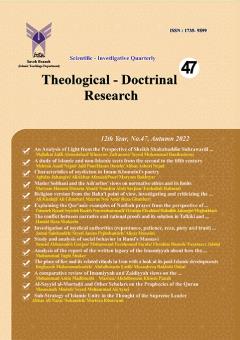-
-
List of Articles
-
Open Access Article
1 - An Analysis of Light from the Perspective of Sheikh Shahabuddin Suhrawardi and Imam Khomeini
Malahat jaliliahmadabad Khosrow Zafar Nawai seyed mohamad banihashemi -
Open Access Article
2 - A study of Islamic and non-Islamic sects from the second to the fifth century
Mehran Asadinejad Jalil PourHasan Darabi Abbas Ashuri Nejad -
Open Access Article
3 - Characteristics of mysticism in Imam Khomeini's poetry
aghdas jahangiri Ali Akbar Afrasiab pour Maryam Bakhtyar -
Open Access Article
4 - Master Sobhani and the Ash'arites' views on normative ethics and its limits
Maryam Hatami Hossein Abadi noushin abdi savojiyan Enshaallah Rahmati -
Open Access Article
5 - Religion version from the Baha'i point of view, investigating and criticizing the point of view with emphasis on the fifth verse of Surah As-Sajdah
ali khalaji ali ghanbari amir khalili -
Open Access Article
6 - Explaining the Qur'anic examples of Nadbah prayer from the perspective of contemporary commentators
fatemeh rezaii seyedeh razieh pourmohammadi ebrahim ebrahimi Ruhollah Jahangiri Moghaddam -
Open Access Article
7 - The conflict between narrative and rational proofs and its solution in Tafkiki and shia philosophical theology
حمیدرضا شاکرین -
Open Access Article
8 - Investigation of mystical authorities (repentance, patience, reza, piety and trust) In the works of Imam Khomeini and Imam Mohammad Ghazali
Jamal Salehzadeh Seyed Jasem Pejhohandeh Aliyar Hosseini -
Open Access Article
9 - Study and analysis of social behavior in Rumi's Masnavi
Samad Abbaszadeh Garjan Mohammad Farahmand Ebrahim Danesh Faramarz Jalalat -
Open Access Article
10 - Analysis of the report of the written legacy of the Imamiyyah about how the lives of the religious leaders ended
دکتر محمدتقی شاکر -
Open Access Article
11 - The place of fire and its related rituals in Iran with a look at its post-Islamic developments
رقیه محمدزاده عبد الحسین لطیفی Musa Reza Bakhshi -
Open Access Article
12 - A comparative review of Imamiyyah and Zaidiyyah views on the reasons for the superiority of Shia imams over previous prophets
Mohammad Amin madhooshi mazraei abdolhosain khosropanah -
Open Access Article
13 - Al-Sayyid al-Murtaḍā and Other Scholars on the Prophecies of the Quran
Masume Mostofi mohammad ali ayazi -
Open Access Article
14 - Sub-Strategy of Islamic Unity in the Thought of the Supreme Leader
Abbas Ali Nazar Nokandeh Morteza Khorrami
-
The rights to this website are owned by the Raimag Press Management System.
Copyright © 2017-2025







